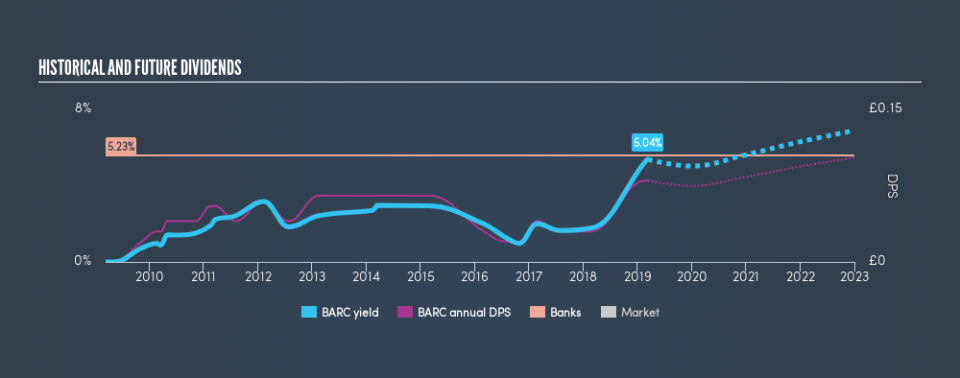How Does Barclays PLC (LON:BARC) Fare As A Dividend Stock?

A large part of investment returns can be generated by dividend-paying stock given their role in compounding returns over time. Historically, Barclays PLC (LON:BARC) has paid a dividend to shareholders. It currently yields 5.0%. Should it have a place in your portfolio? Let’s take a look at Barclays in more detail.
See our latest analysis for Barclays
5 questions I ask before picking a dividend stock
When researching a dividend stock, I always follow the following screening criteria:
Is their annual yield among the top 25% of dividend payers?
Has its dividend been stable over the past (i.e. no missed payments or significant payout cuts)?
Has the amount of dividend per share grown over the past?
Can it afford to pay the current rate of dividends from its earnings?
Will it be able to continue to payout at the current rate in the future?
How well does Barclays fit our criteria?
The current trailing twelve-month payout ratio for the stock is 69%, meaning the dividend is sufficiently covered by earnings. However, going forward, analysts expect BARC’s payout to fall to 36% of its earnings. Assuming a constant share price, this equates to a dividend yield of around 5.3%. However, EPS should increase to £0.22, meaning that the lower payout ratio does not necessarily implicate a lower dividend payment.
When thinking about whether a dividend is sustainable, another factor to consider is the cash flow. A company with strong cash flow, relative to earnings, can sometimes sustain a high pay out ratio.
Reliablity is an important factor for dividend stocks, particularly for income investors who want a strong track record of payment and a positive outlook for future payout. The reality is that it is too early to consider Barclays as a dividend investment. It has only been consistently paying dividends for 9 years, however, standard practice for reliable payers is to look for a 10-year minimum track record.
In terms of its peers, Barclays generates a yield of 5.0%, which is on the low-side for Banks stocks.
Next Steps:
Taking all the above into account, Barclays is a complicated pick for dividend investors given that there are a couple of positive things about it as well as negative. But if you are not exclusively a dividend investor, the stock could still be an interesting investment opportunity. Given that this is purely a dividend analysis, I urge potential investors to try and get a good understanding of the underlying business and its fundamentals before deciding on an investment. I’ve put together three relevant aspects you should look at:
Future Outlook: What are well-informed industry analysts predicting for BARC’s future growth? Take a look at our free research report of analyst consensus for BARC’s outlook.
Valuation: What is BARC worth today? Even if the stock is a cash cow, it’s not worth an infinite price. The intrinsic value infographic in our free research report helps visualize whether BARC is currently mispriced by the market.
Dividend Rockstars: Are there better dividend payers with stronger fundamentals out there? Check out our free list of these great stocks here.
We aim to bring you long-term focused research analysis driven by fundamental data. Note that our analysis may not factor in the latest price-sensitive company announcements or qualitative material.
If you spot an error that warrants correction, please contact the editor at editorial-team@simplywallst.com. This article by Simply Wall St is general in nature. It does not constitute a recommendation to buy or sell any stock, and does not take account of your objectives, or your financial situation. Simply Wall St has no position in the stocks mentioned. Thank you for reading.


